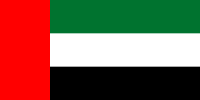List of Intangible Cultural Heritage elements in the United Arab Emirates

The United Nations Educational, Scientific and Cultural Organisation (UNESCO) intangible cultural heritage elements are the non-physical traditions and practices performed by a people. As part of a country's cultural heritage, they include celebrations, festivals, performances, oral traditions, music, and the making of handicrafts.[1] The "intangible cultural heritage" is defined by the Convention for the Safeguarding of Intangible Cultural Heritage, drafted in 2003[2] and took effect in 2006.[3] Inscription of new heritage elements on the UNESCO Intangible Cultural Heritage Lists is determined by the Intergovernmental Committee for the Safeguarding of Intangible Cultural Heritage, an organisation established by the convention.[4]
The United Arab Emirates signed the convention on 2 May 2005.
Intangible Cultural Heritage elements
[edit]Representative List
[edit]| Name | Image | Year | No. | Description |
|---|---|---|---|---|
| Al-Taghrooda, traditional Bedouin chanted poetry in the United Arab Emirates and the Sultanate of Oman +[a] | 2012 | 00744 | ||
| Al-Ayyala, a traditional performing art of the Sultanate of Oman and the United Arab Emirates +[b] | 
|
2014 | 01012 | Al-Ayyala is a weapon dance traditionally performed during weddings, celebrations, and other events. |
| Majlis, a cultural and social space +[c] | 2015 | 01076 | Majlis –meaning "sitting room"– is a meeting place for society's individuals to debate matters and local issues, and exchanging news whether public affairs news or what concern the attendees. | |
| Arabic coffee, a symbol of generosity +[d] | 
|
2015 | 01074 | |
| Al-Razfa, a traditional performing art +[e] | 2015 | 01078 | ||
| Camel racing, a social practice and a festive heritage associated with camels +[f] | 
|
2020 | 01576 | |
| Al Aflaj, traditional irrigation network system in the UAE, oral traditions, knowledge and skills of construction, maintenance and equitable water distribution | 
|
2020 | 01577 | |
| Falconry, a living human heritage +[g] | 
|
2021 | 01708 | The origin of falconry goes back to the use of hunting by birds of prey as a mean of hunting but it has evolved over time to become part of the cultural heritage of the people. |
| Arabic calligraphy: knowledge, skills and practices +[h] | 2021 | 01718 | The artistic practice of writing Arabic letters and words to convey grace and beauty. | |
| Al Talli, traditional embroidery skills in the United Arab Emirates | 2022 | 01712 | ||
| Alheda'a, oral traditions of calling camel flocks +[i] | 
|
2022 | 01717 | Alheda'a is an oral tradition of calling a flock of camels passed on through generations. |
| Date palm, knowledge, skills, traditions and practices +[j] | 
|
2022 | 01902 | The Palm tree is considered to be a part of the history of the countries where it is a source for farmers, craftsmen, handicrafts owners, merchants, factory owners and food companies. |
| Harees dish: know-how, skills and practices +[k] | 2023 | 01744 | Harees, is a dish of boiled, cracked, or coarsely-ground cracked wheat or bulgur, mixed with meat and seasoned. |
Elements in Need of Urgent Safeguarding
[edit]| Name | Year | No. | Description |
|---|---|---|---|
| Al Sadu, traditional weaving skills in the United Arab Emirates | 2011 | 00517 | Al Sadu, or simply Sadu, describes an embroidery form in geometrical shapes hand-woven by Bedouin people. |
| Al Azi, art of performing praise, pride and fortitude poetry | 2017 | 01268 |
See also
[edit]Notes
[edit]- ^ Shared with Oman.
- ^ Shared with Oman.
- ^ Shared with Oman, Qatar, and Saudi Arabia.
- ^ Shared with Oman, Qatar, and Saudi Arabia.
- ^ Shared with Oman.
- ^ Shared with Oman.
- ^ Shared with Austria, Belgium, Croatia, Czechia, France, Germany, Hungary, Ireland, Italy, Kazakhstan, Republic of Korea, Kyrgyzstan, Mongolia, Morocco, Netherlands, Pakistan, Poland, Portugal, Qatar, Slovakia, Saudi Arabia, Spain, and Syria.
- ^ Shared with Algeria, Bahrain, Egypt, Iraq, Jordan, Kuwait, Lebanon, Mauritania, Morocco, Oman, Palestine, Saudi Arabia, Sudan, Tunisia, and Yemen.
- ^ Shared with Oman and Saudi Arabia.
- ^ Shared with Bahrain, Egypt, Iraq, Jordan, Kuwait, Mauritania, Morocco, Oman, Palestine, Qatar, Saudi Arabia, Sudan, Tunisia, and Yemen.
- ^ Shared Oman and Saudi Arabia.
References
[edit]- ^ "What is Intangible Cultural Heritage?". UNESCO Intangible Cultural Heritage. Retrieved 13 January 2024.
- ^ "Text of the Convention for the Safeguarding of Intangible Cultural Heritage". UNESCO Intangible Cultural Heritage. Retrieved 13 January 2024.
- ^ "The States Parties to the Convention for the Safeguarding of the Intangible Cultural Heritage (2003)". UNESCO Intangible Cultural Heritage. Retrieved 13 January 2024.
- ^ "Functions of the Intergovernmental Committee for the Safeguarding of Intangible Cultural Heritage". UNESCO Intangible Cultural Heritage. Retrieved 13 January 2024.
External links
[edit]- UNESCO Intangible Cultural Heritage: Official site
- UNESCO Intangible Cultural Heritage in the United Arab Emirates: Official site


